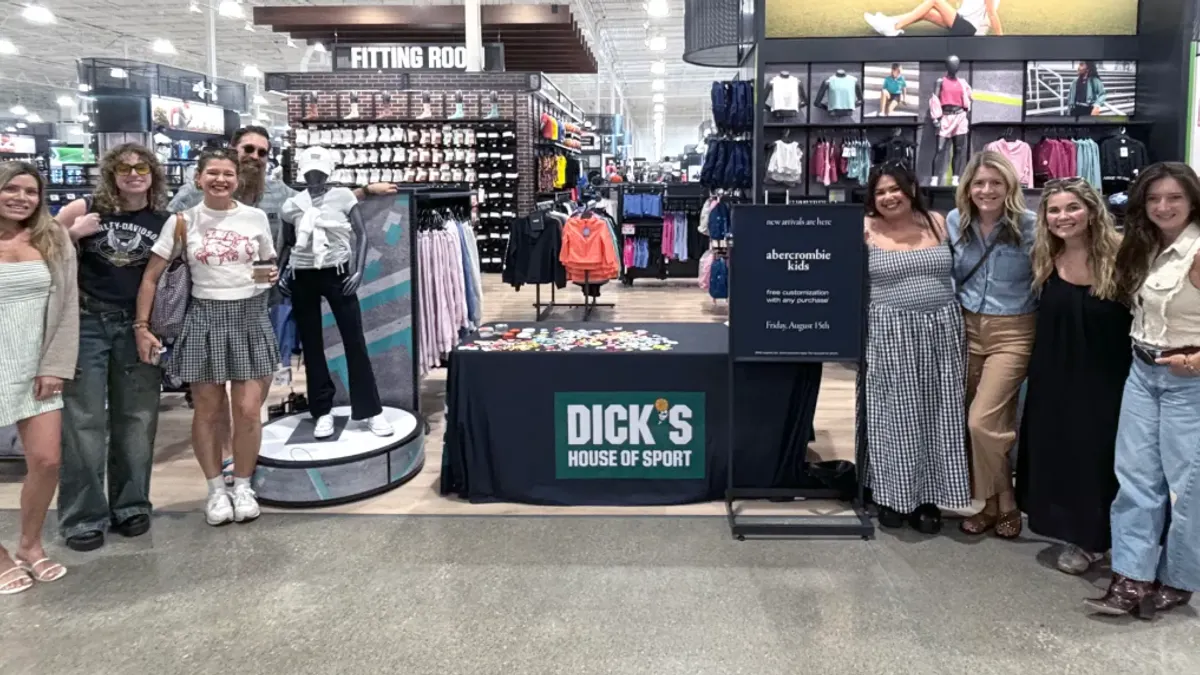Retail media has claimed the crown as digital’s fastest-growing channel, acting as a magnet for ad dollars from brands facing signal loss and gravitating toward performance marketing. The narrative has been one of breathless growth, with retailers touting massive gains from their bets on selling ads that lean on customer data. Now comes the hard part.
This year, the focus for retail media networks is shifting from onsite advertising — running campaigns on assets the retailer owns, like a website — to the offsite world, in areas like connected TV, social and open-web programmatic. Retail media networks execs view offsite as a swing at the big leagues, a chance to prove their first-party data power can extend beyond retail to reshape the wider digital landscape.
“It is a real expansion, I think, of the value proposition that retail media can provide,” said Ali Miller, vice president of ads product at Instacart, which works with platforms like Google, Roku and NBCUniversal.
However, the risk for retail media networks looking to broaden their appeal could be significant. Without the proper safeguards in place, retailers could end up contributing to programmatic’s transparency woes. Even worse, individual networks could undermine their value proposition to advertisers at a time when standing out against the growing competition is critical.
For now, advertisers and publishers seem to be buying in. Ad spending on offsite programmatic retail media will hit $20 billion this year, a massive leap over the $7.5 billion recorded in 2023, according to researcher Advertiser Perceptions. Media heavyweights like Disney are linking with some of the biggest retail media networks to improve the precision of connected TV campaigns as buyers prioritize driving business outcomes over the usual video metrics like reach and frequency.
But underpinning the offsite trend are pressures, including strains on supply. Mature retail media networks are nearing the limit of how many ads they can run onsite without hurting the user experience. On the flip side, more nascent networks can’t compete as well when it comes to onsite inventory, placing them at a disadvantage without offsite levers to pull.
“One of the biggest drivers here of why off-property is expanding and going to expand so much faster is the inventory is limited on-property,” said Nicole Perrin, senior vice president of business intelligence at Advertiser Perceptions. “It is essentially unlimited off-property.”
Google’s reversal on cookie deprecation is unlikely to dampen the desire for retail media as chief marketing officers are tasked with making their advertising more performant. Offsite then stands to be a lucrative opportunity, but one with very different financial, privacy and ad quality considerations.
“At its best, [offsite] is really the promise of additional scale and performance,” said Nicholas Ward, co-founder and president of ad-tech firm Koddi. “At its worst, it can be sold and resold data from trusted customers, and it’s ending up on Made For Advertising sites.”
‘Oh s---t, where’s my supply?’
Offsite activity is on the rise as retail media’s overall rate of growth is expected to cool. Ad spending on the channel will grow 10.6% in 2025, a roughly three percentage-point drop compared to 2024, as trade budgets start to be exhausted, per WARC.
“We’re coming up to the end of a phase transition in retail media, in commerce media, where the story was the growth,” Ward said.
Retail media networks see offsite as a way to win over nonendemic advertisers, such as financial services and automotive. Those buyers could provide a boost as CPGs are tapped out. Offsite also tends to skew upper-funnel compared to onsite, when consumers are already visiting a retailer to make a purchase. But offsite media also represents an adjustment in advertising returns and the degree of control retailers can exert, presenting a steep learning curve for platforms that are, in many cases, still learning the marketing ropes.
“The reality is that it’s lower margin,” said Andrew Lipsman, an independent analyst at Media, Ads + Commerce. “It’s still healthy margins, but when you’re talking about onsite being often 80% to 90% gross margin, offsite might be 20% to 40%.”
Those results remain appealing to retailers whose core businesses carry even thinner margins. However, offsite’s lower returns compounded with onsite supply constraints come at a time when retail media is receiving more public scrutiny.
"A lot of that growth was predicated on having unlimited supply for this overwhelming demand. Now, they’re like, ‘Oh s---t, where’s my supply?’”

Michael Jaconi
Co-Founder and CEO, Button
Companies like Walmart and Amazon have started to make ad sales a big part of their earnings discussions with Wall Street, and retailers broadly see the strategy as a way to boost profits. If the future growth trajectory doesn’t line up with the expectations retail media networks have set so far, there could be a reckoning.
“As the retailers were looking a quarter or a year ahead and starting, in the public markets, to talk about their growth of these initiatives, a lot of that growth was predicated on having unlimited supply for this overwhelming demand,” said Michael Jaconi, co-founder and CEO of retail media solutions provider Button. “Now, they’re like, ‘Oh s---t, where’s my supply?’”
Wading into murky waters
A different financial picture is just one piece of the offsite retail media puzzle. Retailers are not historically sophisticated with digital media, and many have built out their onsite offerings with the aid of outside vendors.
“Getting into the ad-selling space is not a core competency [for retailers] and not all of them have enough talent to support some of these opportunities."

Andrew Lipsman
Analyst, Media, Ads + Commerce
Offsite adds additional layers of complexity to the equation. Retail media data is plugged into third-party services, like demand-side platforms and apps, to be spread around the internet.
“You can create a situation where maybe if you push your data out to too many places, you actually disintermediate yourself in a sense and reduce the value [proposition] that you ultimately have,” Ward said.
Programmatic is also in the spotlight in the wake of research that uncovered a high amount of waste on Made For Advertising sites: clickbait content farms that use shady tactics to mask their purpose of maximizing ad loads. While progress has been made combating Made For Advertising site, retailers must ensure their offsite blitz doesn’t exacerbate the problem. A lack of care in executing the push into open-web programmatic could also reduce retail media performance, a crucial driver of advertiser interest.
“Great targeting data against bot traffic is going to have zero effect,” Lipsman said. “Getting into the ad-selling space is not a core competency [for retailers] and not all of them have enough talent to support some of these opportunities.”
Build, rent or buy
Some retail media networks are better equipped to surmount these hurdles than others. As retail media investments soar, platforms like Amazon and Walmart have enshrined a dominant position (the former is big enough to effectively act in its own category). Those with the deepest pockets can staff up experienced talent, develop proprietary ad tech and acquire media properties that hone their upper-funnel muscles.
“The challenge for a not top-five or top-10 retailer to build offsite is that it’s a lot of technology and a lot of capabilities,” Jaconi said.
The disparities could be particularly sharp in connected TV, an offsite channel where marketers are spending heavily. Amazon opened the floodgates for the connected TV-retail media convergence when it started running commercials on Prime Video in January. Walmart earlier this year acquired the smart TV maker Vizio for $2.3 billion to shore up its own video strengths. Few other retail media networks will be able to fully capitalize on the connected TV boom.
“If you’re not an Amazon that has [its] own streaming TV platform, or you’re not a Walmart that has a Vizio platform, you need to fulfill those goals elsewhere,” Perrin said.
Another route retail media networks could take is publisher partnerships in the model of Best Buy’s with CNet and Instacart’s with The New York Times Cooking. Digital media publishers are cheaper to work with, and some currently have fire sale price tags.
“We could potentially see M&A because a lot of the media companies’ valuations are depressed,” Lipsman said.
Out of ahead of their skis
As retail media networks ready their next chapter, they will continue to be dogged by questions about whether they’ll repeat the mistakes of walled gardens past. Analysts are in agreement that retail media can deliver superior performance but the drive for sustaining short-term profits, enabled by rapid offsite expansion, might put retailers out ahead of their skis.
Advertisers, meanwhile, express mixed feelings, coveting the first-party data but feeling frustration that retailers enforce retail media buys as part of marketing agreements. Almost two-thirds of brands surveyed by the Association of National Advertisers, a trade body representing marketers, view retail media networks as a “have to buy” versus “want to buy” strategy. Will those sentiments grow sour or more positive in the offsite era?
“The promise, again, is this connected experience across the board,” said Koddi’s Ward. “The risk is that we’re selling something as an industry that maybe is not quite there yet.”























